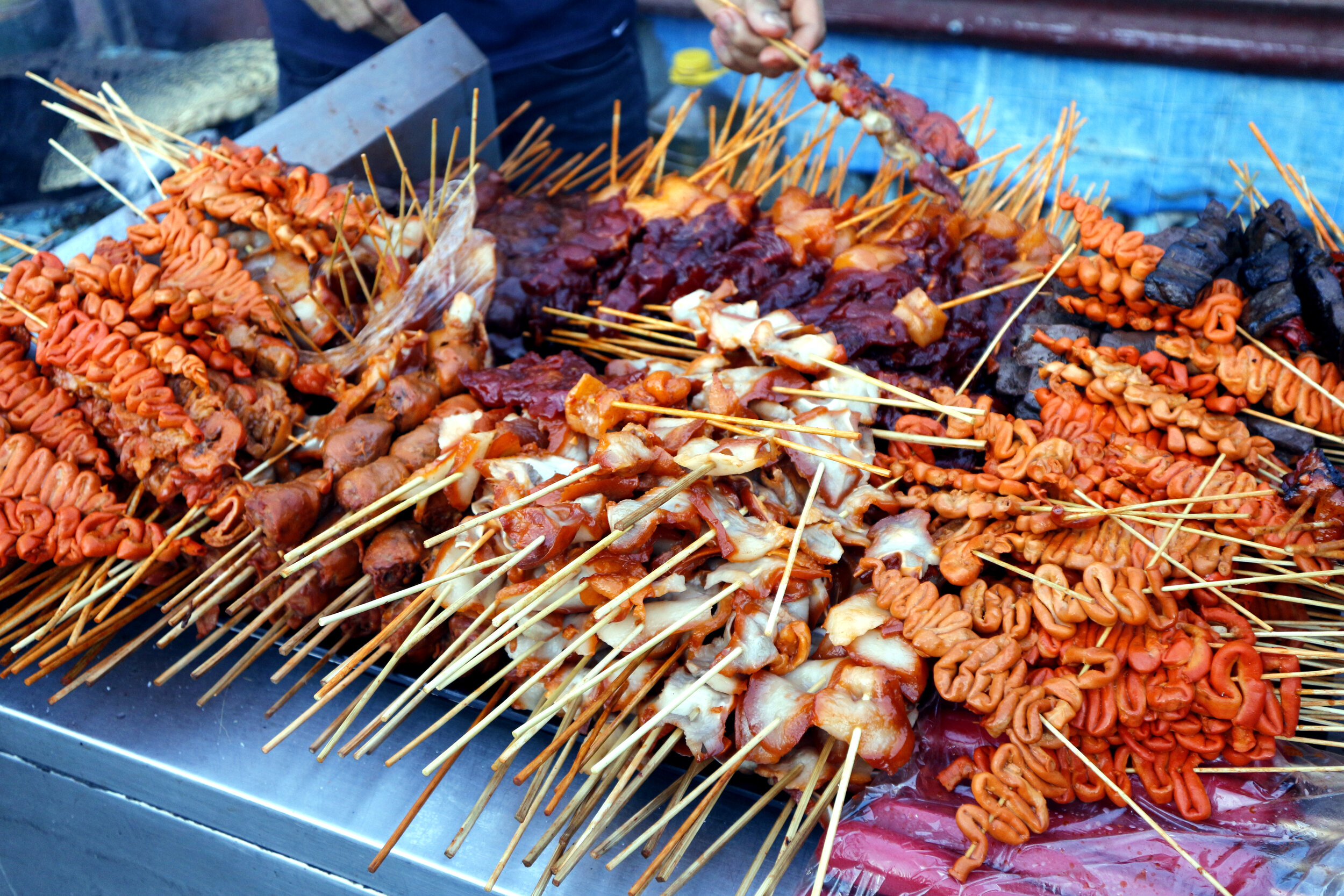Foodie Guide to Filipino Street Food!
Filipino Food Culture
When visiting the Philippines, indulging in the Filipino street food scene is no doubt one of the best ways to get immersed in the country's food culture, enjoy the most authentic Philippine cuisine, and probably make some new Filipino friends along the way. After all, food is what brings people together, and the food of the Philippines is no different in that regard.
If you have travelled through other parts of Asia, you will realize that a lot of Filipino cuisine has a thing or two in common with Chinese cuisine, the cuisines of neighboring countries in Southeast Asia, and even some western cuisines.
The Philippines has been colonized by a number of nearby Asian countries and western nations, and this has influenced Filipino food. You will find that in Filipino food markets, street food stalls, and local eateries, a number of dishes are some variation of Indian, Japanese, Chinese, Spanish, or western cuisines. Settlers from other countries have not only influenced Filipino cuisine, but Filipino culture as a whole, and in particular the arts and crafts of the Philippines.
Most traditional Filipino foods are meat based, and so are most of the best street foods in the Philippines. Lechon (Filipino whole roasted pig) and Lechon Manok (Filipino roasted chicken) are both found cooking along the streets of the Philippines, with the chicken version being so popular there is often a line of locals waiting to order.
The best places to find the greatest variety of Filipino street food, and to see a bustling array of street vendors at their vibrant stalls pumping out authentic Filipino dishes, is in the bigger cities. Think Manila, the country’s capital, or explore Cebu, which is where most foreigners land to explore the amazing waterfalls in the country’s south. Both locations will certainly have the items on our Filipino street foods list for you to enjoy.
But this doesn’t mean you won’t find popular Filipino street foods or quick meals in other parts of the Philippines. From the beaches in Boracay to the busy streets of metro Manila, traditional Filipino food can be found at small canteen shops. These small eateries offer a selection of local cuisines and dishes. The main ingredient is plain white rice, which is usually accompanied by 2 or 3 small portions of side dishes.
Must-Try Filipino Street Food List
Lechon—A National Dish of the Philippines
I thought I would start off this list of Filipino street food with a national dish of the Philippines, Lechon, also known as Lechon Baboy. The term “lechon” comes from the Spanish, who once ruled the Philippines, and translates as suckling pig.
As a Philippine national dish, it’s an especially popular meal during family get-togethers, wedding parties, and other festive occasions.
That being said, Lechon isn’t necessarily a dish you’ll come across too often. Although it’s one of the best street foods in Philippines, we found that most eateries would start preparing the whole roast pork only on weekends, and only the bigger restaurants that get loads of customers would have this dish more frequently. So, if you see this most popular street food, do your taste buds a favor and dig in. Do not pass up this ultimate pork barbecue opportunity!
What to expect is tender and juicy meat with an outer crackling skin that provides just the right crunch in combination with a layer of tasty pork fat.
Filipinos seem to be the masters of roast pork, and I can easily say that the roast pork we tried in the Philippines was the best ever. Each time we had it, it was cooked to perfection. The reason for this perfection is simple: There are master lechoneers who take time and effort to constantly shift the heat so that the pork cooks evenly and is moist throughout. This process is time consuming, but definitely worth it! It’s truly one of the best things you will come across on any street corner anywhere.
We first tried Lechon while cruising around for an evening meal on Siquijor Island. A small stall was just off the main road and a whole pig was displayed on the side of a gravel road. We had the opportunity to choose whichever cut of pork we wanted, and it was incredible. Price: around Php 250 for ¼ kg.
Lechon Manok—A Popular Filipino Street Food
As I said, Lechon Manok is Filipino roasted chicken. It’s similar to what you can find in western countries when whole chickens are grilled rotisserie style. But instead of using an electric oven, in the Philippines the whole chicken slowly rotates over an open flame with the help of a small motor.
The chickens are roasted just the right amount of time to be cooked without drying out the meat. This cooking process leaves the meat juicy inside and a crunchy grilled skin on the outside. The open flames impart a slightly smoky flavor with a charcoal twist.
Lechon Manok can easily be found in many popular areas and where lots of locals pass by. The small, low-key Filipino food stalls serving this dish usually open in the evening, and you can expect a line of customers, especially in areas where there is just a single stall.
A whole roast chicken will cost from Php150 ($3) to Php300 ($6). For the most part, the higher prices are found in Manila.
BalUt—Infamous Filipino Delicacy
So, the first two entries on our must-try list are dishes that many foodies have some level of familiarity with. Balut is where Filipino street food takes a turn and gets much more interesting.
Balut is the infamous Filipino delicacy: fertilized duck egg. Specifically, it’s a boiled duck egg with a duck embryo inside.
Although the first thought of this puts many off, even myself, I must say that Balut is rather tasty once you forget about what you’re actually eating. And after all, it is nothing more than a boiled egg and a small duck. At least that was my reasoning before I tried Balut. And in the Philippines, even many kids love it!
I actually tried Balut in Cebu City on the first night we landed in the Philippines. You will usually find it on Filipino streets during nighttime. That was actually a good thing for me because I couldn’t really see what I was about to bite into.
Balut is usually consumed with some salt and vinegar. Just peel the top of the egg off, splash on some vinegar, sprinkle with salt, and drink all the liquid inside. This is actually the best part of Balut and tastes like broth. The solids inside the egg taste like a combination of duck and egg, with hardest part being the egg white.
Balut is found throughout the Philippines. Prices range from Php15 ($0.30) to Php25 ($0.50), depending on the size and incubation time.
Kwek Kwek—Traditional Food of the Philippines
Kwek Kwek are boiled eggs coated in an orange batter and deep fried until the batter is crispy. Traditionally duck eggs are used, however quail eggs are also common. You can easily spot these quick bites from their bright orange color.
Kwek Kwek are served on bamboo skewers, and for the best result are dipped in some vinegar and accompanied by some onion and chilies. We paid Php15 ($0.30) for 4 eggs.
Isaw—A Famous Filipino Street Food
Isaw must be the king of all street foods in the Philippines and is also common throughout Southeast Asia. Isaw are intestines of either pork or chicken that are grilled over an open fire.
As is the case with most Filipino barbecue, the Isaw grills light up between late afternoon and evening time. The pork or chicken intestines are skewered and grilled over fire until charred.
Isaw are a bit chewy on the outer skin portion where they’ve been grilled, but they taste tender on the inside.
Isaw are served with chili vinegar to enhance the taste. Price: Php5 ($0.10) for 1 skewer.
Sotanghon—A Filipino Noodle Dish
A common noodle dish you will find in the Philippines is Sotanghon. The noodles used in this dish are usually glass noodles cooked in a unique and tasty broth.
The noodles are cooked in a meaty, oily broth along with beans and topped off with a hard-boiled chicken egg. The slippery glass noodles and oily broth make this a dish you can easily eat on the go. Just slurp through your meal while taking bites out of the hard-boiled egg for that bit of chew.
You can easily identify this dish at a Filipino street market by looking for the eggs floating in a dark glass noodle soup. Price for this dish is about Php25 ($0.50) to Php30 ($0.60).
Halo Halo—Filipino Dessert
Halo Halo reigns among the best desserts in the Philippines. So, I thought it would be a great way to finish off this list of the best street food in the Philippines.
Halo Halo in the Filipino language means “mixture,” and that is basically what this Filipino sweet treat is all about.
This cold Filipino dessert is a mixture of shaved ice topped with a combination of fruit, sweet beans, condensed milk, jellies, syrup, and a scoop of usually purple ice cream. Price: Php30 ($0.60).
Filipino Food at Local Canteens
If you can’t find a street food vendor, or wish to sit and eat, go to the local canteen. These low key eateries are the Filipino answer to fast food and are easily found wherever you go.
They are commonly a small local market that serves a variety of dishes along with rice. But you will usually find something similar on the side of the street. In fact, we even came across places serving a quick meal in the middle of farmland along a main artery road in Dumaguete.
Most common dishes are chorizo sausage, fried eggs, chicken liver, fried pork or chicken, and sometimes noodles.
These canteens prepare the food early in the morning, and on the rare occasions I had this option as a hot meal, it was when I was out at around 5:00 am and the dishes were just being made. So, basically, beside the rice, which is out of a steamer, these dishes are usually served cold. That’s just something you need to get used to.
Prices vary depending on the ingredients in the dish. Expect to pay around Php50 ($1) for 2 or 3 portions with a side of rice.
About the Author
James Cutajar is an experienced traveler that spent almost 2 years exploring Southeast Asia. Along with his partner Jacqueline, the duo have created a travel website focusing on routes, travel guides, and itineraries on their website thetraveldeck.com












